- Home
- Agencies
- Department of Agriculture
- Department of Housing and Urban Development
- General Services Administration
- Department of Commerce
- Department of the Interior
- National Aeronautics and Space Administration
- Department of Defense
- Department of Justice
- National Science Foundation
- Department of Education
- Department of Labor
- Office of Personnel Management
- Department of Energy
- Department of State
- Small Business Administration
- Environmental Protection Agency
- Department of Transportation
- Social Security Administration
- Department of Health and Human Services
- Department of the Treasury
- U.S. Agency for International Development
- Department of Homeland Security
- Department of Veterans Affairs
- Goals
- Initiatives
- Programs
Primary tabs
Key to Changes
This text is Revised text
This word has been added to the text
This text is Last Published text
This word has been removed from the text
Modifed styling with no visual changes
Strategic Objective
Ensure sustainable investments in affordable rental housing.
Strategic Objective
Overview
The number of renter households with worst case needs – those with very low-incomes[1] that do not receive government assistance and either pay more than half their income on rent or live in severely inadequate conditions – decreased to 7.7 million in 2013 from the record high of 8.5 million in 2011, ending a sustained period of large increases. The Worst Case Housing Needs 2015 Report to Congress[2] study details the continued, substantial unmet needs for affordable rental housing even as economic conditions improve. As the rental market continues to tighten, it is critical to increase the level of private investment into affordable housing. Currently, for every two very low-income households that receive rental assistance, more than three very low-income households have worst case housing needs.
[1] Very low income renters have a household income of 50 percent or less of the area median income, with adjustments for household size.
[2] U.S. Department of Housing and Urban Development, 2015 (April); Worst Case Housing Needs 2015: Report to Congress.
Read Less...Progress Update
There is a critical need for new investments in rental housing across affordability levels for low to moderate income families. Reports such as the Worst Case Housing Needs 2015 Report to Congress show that as the rental market continues to tighten nationwide, it is critical for HUD to encourage housing construction and substantial rehabilitation. Furthering this goal, the Federal Housing Finance Agency (FHFA) directed Fannie Mae and Freddie Mac to allocate funds to the Housing Trust Fund and Capital Magnet Fund, which can be used to provide grants to states to increase and preserve the supply of rental housing for extremely and very low-income families. In addition, HUD has increased its production of rental units across affordability levels, including producing or rehabilitating 28,674 units in FY 2014 and 37,155 in FY 2015 through Multifamily Housing programs.









